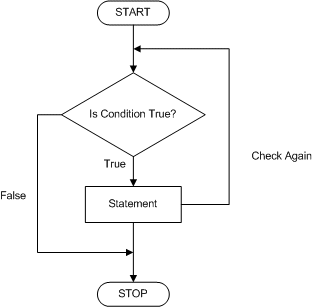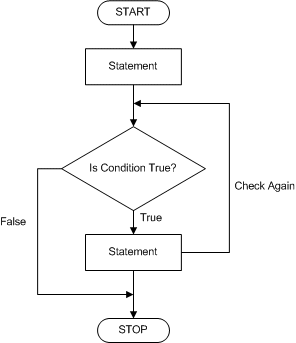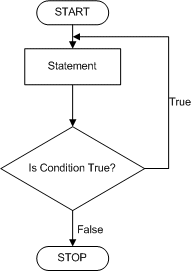|

Here is an example:
using System;
class Program
{
static void Main()
{
int Stories = 0;
while( Stories <= 4 )
{
Console.WriteLine("Number {0}", Stories);
Stories++;
}
Console.WriteLine();
}
}
This would produce:
Number 0
Number 1
Number 2
Number 3
Number 4
Press any key to continue . . .
To effectively execute a while condition, you
should make sure you provide a mechanism for the compiler to use or get a
reference value for the condition, variable, or expression being
checked. This is sometimes in the form of a variable being initialized
although it could be some other expression. Such a while
condition could be illustrated as follows:

|
do This
while a Condition is True
|
|
The while loop is used first check a
condition and then execute a statement. If the condition is false, the
statement would never execute. Consider the following program:
using System;
class Program
{
static void Main()
{
int Stories = 5;
while (Stories <= 4)
{
Console.WriteLine("Number {0}", Stories);
Stories++;
}
Console.WriteLine();
}
}
When this program executes, nothing from the while
loop would execute because, as the condition is checked in the
beginning, it is false and the compiler would not get to the Statement.
In some cases, you may want to execute a statement before checking the
condition for the first time. This can be done using the do…while statement.
Its formula is:
do Statement while (Condition);
The do…while condition executes a Statement
first. After the first execution of the Statement, it examines
the Condition. If the Condition is true, then it executes
the Statement again. It will keep executing the Statement
AS LONG AS the Condition is true. Once the Condition
becomes false, the looping (the execution of the Statement) would
stop.
If the Statement is a short one, such as made
of one line, simply write it after the do keyword. Like the if
and the while statements, the Condition being checked must
be included between parentheses. The whole do…while statement
must end with a semicolon.

Another version of the counting program seen
previously would be:
using System;
class Program
{
static void Main()
{
int Stories = 0;
do
Console.WriteLine("Number {0}", Stories++);
while (Stories <= 4);
Console.WriteLine();
}
}
This would produce:
Number 0
Number 1
Number 2
Number 3
Number 4
Press any key to continue . . .
If the Statement is long and should span more than
one line, start it with an opening curly bracket "{" and end it with a
closing curly bracket "}".
|
 Practical
Learning: Introducing Boolean Variables Practical
Learning: Introducing Boolean Variables |
|
- Start Microsoft Visual C#
- Create a new Console Application named FlowerShop3
- To create a new class, in the Class View, right-click the project name -> Add
-> Class...
- Set the Name of the class to Flower and click Add
- Complete the Flower.cs file as follows:
using System;
namespace FlowerShop3
{
public enum FlowerType
{
Roses = 1,
Lilies,
Daisies,
Carnations,
LivePlant,
Mixed
}
public enum FlowerColor
{
Red = 1,
White,
Yellow,
Pink,
Orange,
Blue,
Lavender,
Mixed
}
public enum FlowerArrangement
{
Bouquet = 1,
Vase,
Basket,
Any
}
class Flower
{
public FlowerType Type;
public FlowerColor Color;
public FlowerArrangement Arrangement;
public decimal UnitPrice;
public Flower()
{
Type = FlowerType.Mixed;
Color = FlowerColor.Mixed;
Arrangement = FlowerArrangement.Vase;
UnitPrice = 0.00M;
}
public Flower(FlowerType type)
{
Type = type;
Color = FlowerColor.Mixed;
Arrangement = FlowerArrangement.Vase;
UnitPrice = 0.00M;
}
public Flower(FlowerType type, FlowerColor color,
FlowerArrangement argn, decimal price)
{
Type = type;
Color = color;
Arrangement = argn;
UnitPrice = price;
}
}
}
|
- To create a new class, in the Solution Explorer, right-click the project
name, position the mouse on Add and click Class...
- Set the Name of the class to OrderProcessing and click Add
- Complete the OrderProcessing.cs file as follows:
using System;
namespace FlowerShop3
{
class OrderProcessing
{
public Flower FlowerOrder;
public int Quantity;
public OrderProcessing()
{
FlowerOrder = new Flower();
}
public decimal GetTotalPrice()
{
return Quantity * FlowerOrder.UnitPrice;
}
public void GetFlowerType()
{
int choice = 0;
do
{
Console.WriteLine("Enter the Type of Flower Order");
Console.WriteLine("1. Roses");
Console.WriteLine("2. Lilies");
Console.WriteLine("3. Daisies");
Console.WriteLine("4. Carnations");
Console.WriteLine("5. Live Plant");
Console.WriteLine("6. Mixed");
Console.Write("Your Choice: ");
choice = int.Parse(Console.ReadLine());
} while ((choice < 1) || (choice > 6));
switch (choice)
{
case 1:
FlowerOrder.Type = FlowerType.Roses;
break;
case 2:
FlowerOrder.Type = FlowerType.Lilies;
break;
case 3:
FlowerOrder.Type = FlowerType.Daisies;
break;
case 4:
FlowerOrder.Type = FlowerType.Carnations;
break;
case 5:
FlowerOrder.Type = FlowerType.LivePlant;
break;
default:
FlowerOrder.Type = FlowerType.Mixed;
break;
}
}
public void GetFlowerColor()
{
int choice = 0;
do
{
Console.WriteLine("Enter the Color");
Console.WriteLine("1. Red");
Console.WriteLine("2. White");
Console.WriteLine("3. Yellow");
Console.WriteLine("4. Pink");
Console.WriteLine("5. Orange");
Console.WriteLine("6. Blue");
Console.WriteLine("7. Lavender");
Console.WriteLine("8. Mixed");
Console.Write("Your Choice: ");
choice = int.Parse(Console.ReadLine());
} while ((choice < 1) || (choice > 8));
switch (choice)
{
case 1:
FlowerOrder.Color = FlowerColor.Red;
break;
case 2:
FlowerOrder.Color = FlowerColor.White;
break;
case 3:
FlowerOrder.Color = FlowerColor.Yellow;
break;
case 4:
FlowerOrder.Color = FlowerColor.Pink;
break;
case 5:
FlowerOrder.Color = FlowerColor.Yellow;
break;
case 6:
FlowerOrder.Color = FlowerColor.Blue;
break;
case 7:
FlowerOrder.Color = FlowerColor.Lavender;
break;
default:
FlowerOrder.Color = FlowerColor.Mixed;
break;
}
}
public void GetFlowerArrangement()
{
int choice = 0;
do
{
Console.WriteLine("Enter the Type of Arrangement");
Console.WriteLine("1. Bouquet");
Console.WriteLine("2. Vase");
Console.WriteLine("3. Basket");
Console.WriteLine("4. Mixed");
Console.Write("Your Choice: ");
choice = int.Parse(Console.ReadLine());
} while ((choice < 1) || (choice > 4));
switch (choice)
{
case 1:
FlowerOrder.Arrangement = FlowerArrangement.Bouquet;
break;
case 2:
FlowerOrder.Arrangement = FlowerArrangement.Vase;
break;
case 3:
FlowerOrder.Arrangement = FlowerArrangement.Basket;
break;
default:
FlowerOrder.Arrangement = FlowerArrangement.Any;
break;
}
}
public void ProcessOrder()
{
GetFlowerType();
GetFlowerColor();
GetFlowerArrangement();
Console.Write("Enter the Unit Price: ");
FlowerOrder.UnitPrice = decimal.Parse(Console.ReadLine());
Console.Write("Enter Quantity: ");
Quantity = int.Parse(Console.ReadLine());
}
public void ShowOrder()
{
Console.WriteLine("=======================");
Console.WriteLine("==-=-=Flower Shop=-=-==");
Console.WriteLine("-----------------------");
Console.WriteLine("Flower Type: {0}", FlowerOrder.Type);
Console.WriteLine("Flower Color: {0}", FlowerOrder.Color);
Console.WriteLine("Arrangement: {0}", FlowerOrder.Arrangement);
Console.WriteLine("Price: {0:C}", FlowerOrder.UnitPrice);
Console.WriteLine("Quantity: {0}", Quantity);
Console.WriteLine("Total Price: {0:C}", GetTotalPrice());
Console.WriteLine("=======================");
}
}
}
|
- Access the Program.cs file and complete it as follows:
using System;
namespace FlowerShop3
{
class Program
{
static void Main()
{
OrderProcessing order = new OrderProcessing();
order.ProcessOrder();
Console.WriteLine();
order.ShowOrder();
Console.WriteLine();
}
}
}
|
- Execute the application and test it. Here is an example:
Enter the Type of Flower Order
1. Roses
2. Lilies
3. Daisies
4. Carnations
5. Live Plant
6. Mixed
Your Choice: 8
Enter the Type of Flower Order
1. Roses
2. Lilies
3. Daisies
4. Carnations
5. Live Plant
6. Mixed
Your Choice: 2
Enter the Color
1. Red
2. White
3. Yellow
4. Pink
5. Orange
6. Blue
7. Lavender
8. Mixed
Your Choice: 9
Enter the Color
1. Red
2. White
3. Yellow
4. Pink
5. Orange
6. Blue
7. Lavender
8. Mixed
Your Choice: 0
Enter the Color
1. Red
2. White
3. Yellow
4. Pink
5. Orange
6. Blue
7. Lavender
8. Mixed
Your Choice: 7
Enter the Type of Arrangement
1. Bouquet
2. Vase
3. Basket
4. Mixed
Your Choice: 8
Enter the Type of Arrangement
1. Bouquet
2. Vase
3. Basket
4. Mixed
Your Choice: 5
Enter the Type of Arrangement
1. Bouquet
2. Vase
3. Basket
4. Mixed
Your Choice: 2
Enter the Unit Price: 42.85
Enter Quantity: 2
=======================
==-=-=Flower Shop=-=-==
-----------------------
Flower Type: Lilies
Flower Color: Lavender
Arrangement: Vase
Price: $42.85
Quantity: 2
Total Price: $85.70
=======================
Press any key to continue . . .
|
- Close the DOS window
The for statement is typically used to count
a number of items. At its regular structure, it is divided in three
parts. The first section specifies the starting point for the count. The
second section sets the counting limit. The last section determines the
counting frequency. The syntax of the for statement is:
for(Start; End; Frequency) Statement;
The Start expression is a variable assigned the
starting value. This could be Count = 0;
The End expression sets the criteria for ending the counting. An example
would be Count < 24; this means the counting would continue as long
as the Count variable is less than 24. When the count is about to rich
24, because in this case 24 is excluded, the counting would stop. To
include the counting limit, use the <= or >= comparison operators
depending on how you are counting.
The Frequency expression would let
the compiler know how many numbers to add or subtract before continuing
with the loop. This expression could be an increment operation such as
++Count.
Here is an example that applies the for statement:
using System;
class Program
{
static void Main()
{
for (int Stories = 0; Stories <= 4; Stories++)
Console.WriteLine("Number {0}", Stories);
Console.WriteLine();
}
}
This would produce:
Number 1
Number 2
Number 3
Number 4
Press any key to continue . . .
|
|

